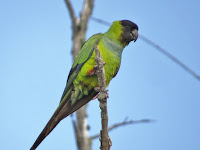Sunday, April 17th
Its amazing how the computer age has made the twitching after a rare or vagrant bird so much easier. At your finger tips is so much up-to-the-minute information. Today, because of eBird, rare bird reports, text messaging, cell phone communications and digital photography, we were able to successfully locate a, possible first ever to be reported in Florida, vagrant Pacific Golden-Plover.
 |
| A Peregrine Falcon at the Sem-Chi Rice Mill |
For a week now, a
Pacific Golden-Plover has been found, in association with
Black-bellied Plovers on a sod farm in the Everglades Ag Area south of Belle Glade. The exact location has been on the Six Mile Bend Sod Farm on CR-880, adjacent to Browns Farm Road, in western Palm Beach County. Bob Pelkey and I arrived on site just after dawn and spent about a half hour in our search before finding the bird. It was quite obviously smaller and darker than its Black-belled cousins. Bob was able to get a few photos before the birds wandered farther away into the sod field. A scope is a diffident must today. By now our friends Stan Damen, Dr Jose Padilla and master birder Vince McGrath arrived to share in enjoying this unusual visitor to south Florida.
See a eBird report and photos of the
Pacific Golden-Plover by Coray Callaghan

All five of us then proceeded to the nearby Sem-Chi Rice Mill to get photographs of the Yellow-headed Blackbirds being seen there. We counted around thirty of these birds, with the males displaying a striking yellow head and throat. A Peregrine Hawk was found to be keeping a close watch on activities at the mill.
Also nearby was Stormwater Treatment Area 1W. Best sighting from there included two pairs of Black-necked Stilts, a Black Skimmer and a pair of Purple Gallinules.
Bob and I also made a stop at The White's home in Alva to try to get photos of the buntings still active about the feeders. A pair of Painted Buntings were still present, as were a few American Goldfinches. About a dozen beautiful Indigo Buntings were also seen here. Plus a calling Northern Parula was foraging overhead and Bob caught sight of a hummingbird too.
This was a very pleasant and rewarding trip today.
Day List (45)
Pacific Golden-Plover , Pied-billed Grebe, Anhinga, Great Blue
Heron, Great Egret, Snowy Egret, Tricolored Heron, White Ibis, Glossy Ibis, Black
Vulture, Swallow-tailed Kite, Bald Eagle, Purple Gallinule, Common Gallinule, Black-necked
Stilt, Black-bellied Plover, Killdeer, Ruddy Turnstone, Laughing Gull, Forster's
Tern, Black Skimmer, Rock Pigeon, Eurasian Collared-Dove, White-winged Dove, Mourning Dove, Common
Nighthawk, Ruby-throated Hummingbird, Crested Caracara, Peregrine Falcon, White-eyed
Vireo, Northern Rough-winged Swallow, Tree Swallow, Barn Swallow, Fish Crow, Common
Yellowthroat, Northern Parula, Red-winged Blackbird, Yellow-headed Blackbird, Eastern Meadowlark, Boat-tailed
Grackle, Common Grackle, Painted Bunting, Indigo Bunting, American Goldfinch, House Sparrow











































